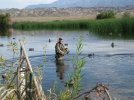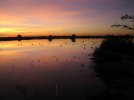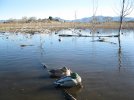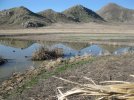My usual theory, and this goes for mostly December and early January, is to always have a bigger spread than the neighboring blinds, which is why I always bring out around 5-6dz floaters and a dz full bodies. But I’m thinking of maybe using 12 or less and spread them out. I’ve had big spreads and have seen birds cupped up into neighboring blinds without anyone calling. Could it be they’re just on the X for that day? Maybe. But maybe only a couple decoys this time of year looks more natural. Only the ducks will know.
@ilovesprig ? What’s your input?
Much depends on where you're hunting...Rule of thumb is, big water, big spread (4+ dozen)...Small water, small spread (2 dozen or less).
And big water is a relative term...Big water can be Lake Henshaw, the sea, or Mystic Lake, but it can also mean the biggest open water at Wister or San J...Hunted a spot at Wister Saturday that had nice open water on the westside and semi choked on the east side...The ducks wanted the eastside...20+ mph winds might have factored in here.
Small water is a pothole or an area that has very little open water...Normally, there's no reason to fill a small area with decoys...You've already have the ducks pinned into a confined spot (here's where good calling can help).
Our ducks are pretty species specific...Teal land with teal, widgeon land with widgeon, spoonies like spoonies, etc...If you're using a mallard call...Then I've always liked having at least a pair of mallard decoys that are very visible...We're only allowed 1 pintail...So, I see no reason to put more than 6 pintail decoys out (separated from the rest)...They are very white...So, there is the sight factor for other ducks (same with spoonie drakes)...If you're hunting a spot that is known for widgeon...Then widgeon decoys should be used...Multiple species, Multiple decoys (separated)
Another factor on big water is decoys that are very visible...The white of pintail, spoons, canvasbacks drakes, etc. can be seen from long distances...Later in the season, and this goes against nature somewhat (drakes get brighter) is using decoys that are darker...Gadwalls, G & H pintails hens, or even coots can be effective.
IMO movement is the key in all these factors...Ducks are rarely stationary...Hence, why windy days can be better for folks that don't use movement...If you don't use some movement, tuck your decoys next to brush or tulies...When they do rest, it's normally tight to structure.
Lots of variables (books are written about stuff like this...LOL), but experience will give you a feel for what is needed in each location you hunt...Good luck
.











